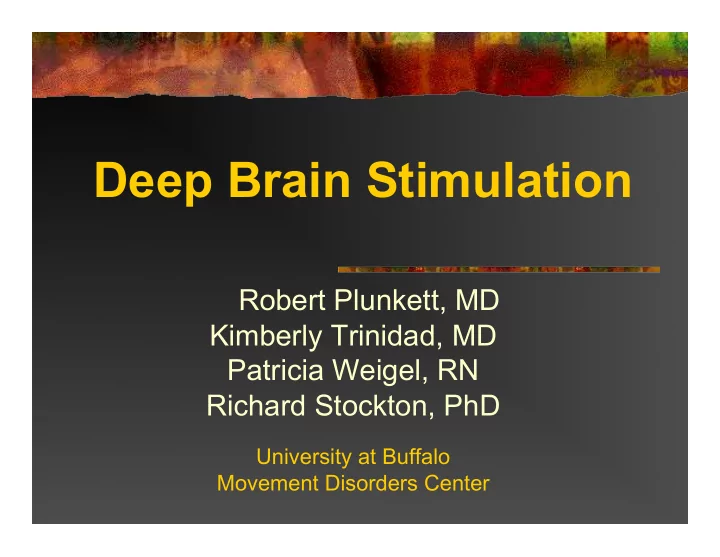

Deep Brain Stimulation Robert Plunkett, MD Kimberly Trinidad, MD Patricia Weigel, RN Richard Stockton, PhD University at Buffalo Movement Disorders Center
Deep Brain Stimulation for Parkinson’s Disease
Approved Indications Essential Tremor FDA approved in 1997 Parkinson’s disease FDA approved in 2002 Dystonia FDA approved (HDE*) in 2003 Obsessive Compulsive Disorder FDA Approved (HDE*) in 2009 Over 30,000 patients implanted worldwide
Deep Brain Stimulation A treatment using a surgically implanted medical device developed to reduce tremor and improve Parkinson’s Disease symptoms Chronic high frequency electrical stimulation of deep brain structures (neuromodulation) Stimulation is adjusted as needed to get the best possible reduction of symptoms
Stages of DBS Surgery Electrode placement Head frame (placed) matched with MRI and CT Target site identified, trajectory planned, coordinates agreed Local anesthetic, one incision, patient awake Microelectrode recordings/mapping target Electrodes implanted Test macrostimulator to confirm site
Stages of DBS Surgery Impulse generator (battery) placement Identify generator needed General anesthetic Two incisions Internalization of wires concealed under scalp and tunneled down neck Generator implanted in chest wall
Implanted Device lead implanted wire tunneled behind the ear and down neck Impulse generator inserted below clavicle
Disease Symptoms Treated Parkinson’s Disease Rest tremor when limb at rest without gravity, rigidity, bradykinesia, and postural instability Essential Tremor Action tremor during voluntary movement which is functionally disabling Multiple Sclerosis Tremor Combination of rest and action tremor which is functionally disabling
DBS for Dystonia Idiopathic primary dystonia Normal cognitive status and MRI Interfering with ADLS or causing musculoskeletal deformity Failed response to oral meds or botulinum toxin A and/or B Realistic expectations, risk/benefit accepted
Parkinson’s Disease Treatment: Continuum of Interventions Disease Severity Mild Moderate Severe Dyskinesi Signs of levodopa Postural Instability, Patient Symptoms a, “On- “wearing-off” Freezing, Falls, Off” Dementia Motor Treatment Levodopa, COMT Agonists Fluctuatio DBS inhibitors, others ns
Ideal Patient Profiles Parkinson’s Patient Idiopathic PD with troubling motor symptoms Optimized on PD meds, continued response to levodopa part of the time, but experiencing unfavorable SE from meds Controlled hypertension, no anticoagulation or other medical conditions contraindicating surgery, no active infectious processes, no significant dementia or depression Moderate to severe dyskinesias Severe motor fluctuations, short “on” time Realistic expectations; risk/benefit acceptable
Parkinson’s Symptoms Treated With DBS Dyskinesias nearly eliminated Off time reduced Rigidity and bradykinesia improved Tremor suppressed Gait and posture variably improved
Outcomes: DBS for PD Overall 85% of patients show improved motor function after DBS Motor fluctuations are significantly reduced These benefits are durable for at least a decade Many patients can reduce their medications guided by their physician
Patient & Family Teaching Extensive pre, peri, and post-op education: pre-tests include, MRI, neuropsychological exam, medical clearance from PMD, routine pre-op tests, EKG etc. levodopa challenge video exam DBS electrode and battery placement procedures explained risks realistic expectations use of DBS device, programming, side effects of stimulation and safety precautions med adjustment
Pre-operative Assessment Neurosurgeon- mechanics and risks Magnetic Resonance Image (MRI) Medical clearance- primary care giver Pre-admission testing- blood work, EKG, chest x-ray
Stereotactic Head Frame
Target Sites for Activa Therapy Vim Thalamus: Subthalamic Nucleus: Globus Pallidus: Essential Tremor Parkinson’s disease Parkinson’s disease and Dystonia and Dystonia
Why Is the Patient Awake? Neurologist activates brain neurons with patient movement to help us locate the area of the brain to place the electrode. Patient cooperates with exams of tremor, muscle tone and rigidity. Assessment of efficacy versus side effects, patient reports any numbness, tingling or other sensations. Drugs interfere with the electrical activity of the brain.
Microelectrode Recording Sounds like static in the background. When we hear a cell, Dr. Trinidad will examine you. The pattern of the cells helps us to locate the correct spot for the electrode.
IntraOp
Risks of Surgery 1-2% chance of intraoperative hemorrhage 3-5% chance of infection 3-5% chance of hardware breakage Transient confusion Perioperative seizure
Deep Brain Stimulator Programming Postpone initial programming 4-6 wks after surgery since micro- lesion effect Withhold meds for first session Programs via telemetry May need a few sessions to optimize results
PD Symptoms Improved With DBS Tremor & rigidity—almost immediate improvement Bradykinesia, akinesia and gait disorders— some pts immediate response, others are delayed Dyskinesia-side effect of meds, usually eliminated Smooths out motor activity
Efficacy: Benefits of Activa Therapy Impact on Mobility Dyskinesia Before After “On” Time “Off” Time This graph is only for illustrative purposes and does not represent actual “on” and “off” time.
After Initial Programming Return to clinic for stimulator and medication adjustments as needed Resume ADL’s Rehab—speech therapy, gait training, support group Most of all—be patient
Common Problems in Parkinsonism and/or Side Effects of Medications
Conclusions For Parkinson’s patients receiving inadequate benefit from optimized pharmacotherapy, DBS can: Reduce symptoms Enhance functional capacity Sometimes reduce medication requirements Successful outcomes from DBS therapy are achieved with: Proper patient selection and education Accurate surgical implantation Optimal post-operative management
Recommend
More recommend